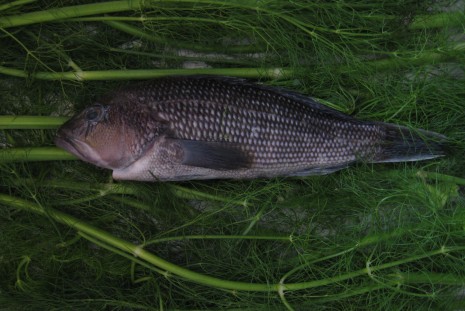BLACK SEA BASS GRILLED OVER FENNEL
A recent dinner party at a friend’s house began with a gorgeous platter of grilled fresh sardines, golden and crisp-skinned. They were delicious, and made me feel on holiday in a Mediterranean port town. They also left me wanting more grilled fish.
As luck would have it, another pal scored some line-caught black sea bass from down around Cape May, New Jersey. Sea bass are at their best fall through winter, before they begin their spring spawning run, and these were real beauts.
You’d be hard-pressed to find a fish better designed for cooking whole. On average, a black sea bass weighs one to three pounds, with a simple, easy-to-see bone structure (reassuring for the fish-phobic) and edible skin that’s striking enough to up the drama quotient when serving. The firm, fine-textured white flesh holds together well (it’s wonderful in chowder or stew); mild and sweet, it’s still distinctive enough in flavor to stand up well to other flavorings—ginger and soy or pungent black bean sauce, for instance, or, if you’re in a surf ‘n’ turf mood, foresty porcini mushrooms.
Still feeling the tug of the Mediterranean, I was inspired to finally deal with our sprawl of fennel plants. They were going to seed and starting to look devitalized, so I gathered an armload of the feathery stalks and a few small bulbs and carted them off to dinner.
Our fish had been gutted on the boat, but the decision on whether to scale them required beer and further discussion. The scales on a bass are as impervious as chainmail, and over live fire, they keep the flesh moist and tender. Still, our fish were going to be lying on a very aromatic fennel bed, and what if that armor protected the meat a little too much? We sighed and got to work, taking care to scrape the fish thoroughly and strip out their sharp, spiny dorsal fins. (If you’re buying whole fish at the store, this work is obligingly done by the guy behind the fish counter.)
Cooking fish, like meat, on the bone always yields more succulence and flavor. When grilling whole fish (or roasting it, our wintertime alternative), aim for cooking it until it is just done in the thickest part of the midsection; the residual heat will finish the job nicely. To check the degree of doneness, insert the tip of a knife, a metal spatula, or a putty knife (my favorite tool for the job) horizontally along the top of the back, where the dorsal fin was, and look inside: The flesh should have turned from translucent to opaque and look like it is going to flake. Don’t leave the fish on the fire until it actually does flake, or else it will overcook.
Black Sea Bass Grilled over Fennel
Serves 4
The key to shopping at any fish market is adaptability: You want what’s sparkling fresh. If black sea bass isn’t available or doesn’t look pristine, substitute striped bass, red snapper, or trout. Spanish mackerel and sardines, lustier in flavor, are outstanding on the grill as well. If you have a supply of Maldon sea salt on hand, scatter those big crunchy flakes over the fish just before serving.
Two 1½- to 2-pound whole black sea bass, cleaned, dorsal fin removed but leaving head and tail intact
Coarse salt and freshly ground black pepper
A generous supply of fennel stalks and fronds, plus 2 fennel bulbs, very thinly sliced
2 fat, juicy-looking garlic cloves, peeled and lightly smashed
2 bay leaves
Olive oil
1. Rinse the fish and pat it dry. Season the inside of each with salt and pepper, then loosely fill with some slices of fennel bulb (save the rest for a salad; see below), the garlic, and bay leaves. Brush the outside of the fish with oil and generously season with salt and pepper.
2. Have your fire medium-hot and ready to go. Put a bed of fennel stalks on the grill rack and the fish on top of the fennel. As the feathery stalks start to crackle and char over the coals, they will smell amazing. Depending on the size of the fish and the heat of the coals, grill the fish on one side for about 6 to 7 minutes, then carefully turn them over (two metal spatulas come in handy). Cook until the fish is opaque (see above) and transfer to a platter.
3. Black sea bass is one of the simplest fish to debone. First, cut nice-sized portions crosswise, down to the fish bones—a.k.a. the frame—then remove the portions with a spatula. Holding the frame by the tail, gently peel it off the underside of the fish. Cut remaining servings the same way.
The rest of our meal couldn’t have been simpler: boiled potatoes, tossed in butter and parsley; a salad of sliced fennel, black olives, and rounds of the season’s first oranges; and a blowsy head of radicchio, cut into wedges and slapped on the grill as an afterthought. We ate outside, by the light of a lantern, and fish scales glinted in the grass.
Posted: September 28th, 2011 under cooking, early autumn, recipes.
Comments
Comment from admin
Time September 30, 2011 at 7:14 am
Wow, what a lovely way to start the day! Thank you so much….All best, Jane



Comment from Cynthia A.
Time September 30, 2011 at 4:56 am
Your words are as delicious to read as your meal was to eat. Thank you for the beautiful writing.